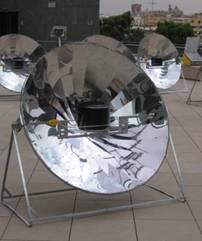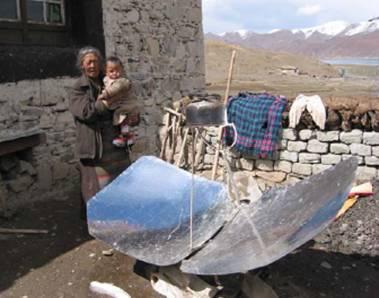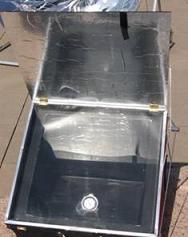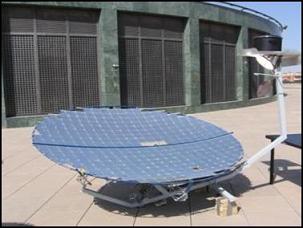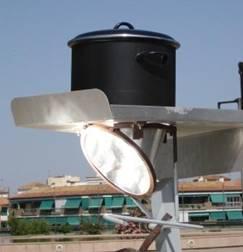Click here to register!
Difference between revisions of "Cooking with the Sun"
***** (***** | *****) |
***** (***** | *****) |
||
| Line 116: | Line 116: | ||
<br>Photo:C. Schwarzer | <br>Photo:C. Schwarzer | ||
| − | <br>As the cooking point is separate from the collector, it is possible to cook in the shade or indoors. The inclusion of a thermal storage unit enables such cookers to be used after sunset, too. To date, around 250 to 300 Schwarzer cookers have been built in India and Africa, often by businesses. | + | <br>As the cooking point is separate from the collector, it is possible to cook in the shade or indoors. The inclusion of a thermal storage unit enables such cookers to be used after sunset, too. To date, around 250 to 300 Schwarzer cookers have been built in India and Africa, often by businesses. |
= Dissemination strategies for solar cookers = | = Dissemination strategies for solar cookers = | ||
Revision as of 09:58, 14 April 2011
NEU
--> Back to Overview Cooking Energy Compendium
Introduction
Probably the most common example associated with the term “fuel-switch” in the head of development enthusiasts is the replacement of biomass as a fuel by sunlight. In tropical countries, sunlight is a strong source of energy at day time which could be used “free of charge” except for the initial investment. As there is no pronounced “winter” season, this opportunity is available for most part of the year.
However, a detailed assessment of the baseline cooking habits and important factors such as convenience, availability, affordability and reliability are important for to elaborate a realistic description of the potentials of such technology-switch:
- The sunlight might be strong all year round, but in the tropics it is restricted to approximately 12 hours a day.
- If food preparation at dawn or sunset is a common feature in the daily routine of the target community, a solar cooker may not be suitable to prepare all meals of the day.
- If overcast at noon is a happening often, food preparation for lunch might be unreliable on a solar cooker.
- If sitting on the ground while cooking is a very important feature, some solar cookers may not be acceptable.
- If heavy stirring of food in a big pot is required to prepare the stable food, women or girls may find it inconvenient to cook on some of the bigger solar cooker models.
- If theft in the night is a big problem, poorer households may not be able to store a hugh solar cooker in their house.
Types of solar cookers
Most solar cookers that have been developed to date fall into four categories: parabolic cookers; box cookers; the Scheffler cooker; and the Schwarzer cookers (the latter two have been named after their inventors). Scheffler cookers are mainly used as institutional cookers as they are too expensive for individual families. Parabolic cookers and box cookers are usually used by households.
Parabolic solar cookers
Parabolic cookers focus radiation from the sun onto the bottom of the pot. They can be made from aluminium sheets, iron, or even concrete coated with aluminium foil. Generally they have a higher energy output than box cookers and can reach temperatures of up to 240 °C. These high temperatures enable users to do cooking, stir-frying and baking. Aluminium parabolic cookers are lightweight and can easily be transported. However, their production requires a high degree of precision and they are usually imported as sets, which are locally assembled. As a result, in most developing countries, aluminium cookers are too expensive for the majority of the population (US$ 100 and above). Furthermore, such cookers are prone to wind damages to the aluminium sheets. In areas of frequent dust storms the sheets tend to become scratched over time, reducing the output by as much as 30 per cent.
To achieve maximum performance, parabolic cookers must be reoriented to the sun about every 20 minutes, which can be cumbersome and inconvenient for the cook, when large amounts of food are cooked. Another problem is that the cook can be dazzled when the cooker is not handled properly. One solution that has been promoted is the use of sunglasses; another approach is to turn the cooker out of the direction of the sun before the food is stirred. Although dazzling can easily be avoided, parabolic cookers are frequently reputed to be dangerous to the eyes, which is not true.
A variation of the parabolic cooker is the so-called Papillon, which has been promoted in Burkina Faso. It has a higher output than the well known SK-14 parabolic model (http://solarcooking.wikia.com/wiki/SK14), is easier to handle and dazzling is less of a problem. However, the price of about 170 € is too high for most developing countries.
The so-called butterfly cooker was developed in Tibet and is one of two models used in the region. It is made from iron by local artisans and the design has successfully been used for many years. Its bowl is coated with reflective aluminium foil or with small mirrors, which can be replaced when damaged. Iron cookers are more expensive than cement cookers and can only be afforded by better-off families. The aluminium foil has to be replaced every two or three years. They are much heavier than cookers made of aluminium and are pushed around on two wheels fitted to the central support of the cooker. To date, the butterfly cooker is one of the most successful solar cooker models. About 70 000 cookers have been built in Tibet, and their use significantly contributes to the overall energy demand of households.
Similar to the butterfly cooker is a model that has a circular bowl made from cement. In Tibet it is easier to construct, cheaper and can be afforded by poorer families. This cooker has been introduced in Afghanistan. The price of the cooker may vary considerably according to the cost of the surface mirrors and the cement. The disadvantages include a bowl that is more prone to breakage, and the weight of the cooker (about 60 kg), making transport and handling difficult. Click here for a step by step instruction on how to build the cooker .
Photo:B. Clasen
Solar Box cookers
Solar box cookers are much easier to construct than parabolic cookers and are frequently made from local materials by local artisans after they have been trained (Download: Solarbox.pdf). Box cookers are less powerful than parabolic cookers and do not reach temperatures above 180 °C. Stir-frying is not possible, which makes them unsuitable for countries where this type of cooking is common. However, they are easy to handle, orientation to the sun is not as important as for parabolic cookers, and if the sun is temporarily covered by clouds, the temperature does not drop as fast as in parabolic cookers. During cloudy weather, a box cooker can serve as a retained heat cooker. Box cookers have been successfully disseminated in Bolivia. (CEDESOL-Lasting_Impacts.pdf).
Scheffler cooker
A third type of solar cooker is the so-called ‘Scheffler cooker’, where sunlight is focused by a large reflector to a secondary reflector that heats the pot. One advantage is that the secondary reflector can be located inside a building, with an opening left for the sun’s rays to pass into the building, whilst the cook can work in the shade. Scheffler cookers have a much higher output (several kilowatts) than the other cooker types. Several Scheffler cookers can be combined to form sets with an output of several hundred kilowatts.
The high output makes Scheffler cookers especially suitable for institutions, but for individual households the cooker is too expensive. Scheffler cookers have been disseminated mainly in India and Latin America for institutions such as schools or ashrams.
One of the largest Scheffler cookers used in an Indian ashram consists of 86 individual modules which can cook up to 36 000 meals per day, and can heat up to ten cubic meters of water. This gives a daily saving of about 350 litres of diesel. In contrast to other types of solar cooker, tracking the sun is automated in Scheffler cookers. The tracking is driven either by a photovoltaic or gravity device. This makes the cooker very convenient to use. However, since the tracking device requires regular maintenance, it should only be used where this can be assured. In general, the Scheffler cooker is technically the most advanced type, but it is costly, and requires skills to make it work well. To date, a few hundred cookers have been installed worldwide in institutions, mainly in India (127_deepak_gadhia.pdf).
Schwarzer cooker
A fourth type of solar cooker is a flat-plate collector cooker: the Schwarzer cooker, named after its developer. This design uses collectors to heat a medium, such as steam or oil, to transfer heat to where it is needed for cooking. These cookers can be made as large as necessary, allowing their output to be matched to the needs of institutions or individual households. They are not easily transported, but once installed, the cookers do not need to be adjusted to track the sun, which makes their use more convenient.
Photo:C. Schwarzer
As the cooking point is separate from the collector, it is possible to cook in the shade or indoors. The inclusion of a thermal storage unit enables such cookers to be used after sunset, too. To date, around 250 to 300 Schwarzer cookers have been built in India and Africa, often by businesses.
Dissemination strategies for solar cookers
For dissemination of solar cookers several strategies have been applied individually or in combination:
- State-controlled dissemination programmes at sometimes heavily subsidised prices, or free of charge (China)
- Commercial dissemination of subsidised models (China, India)
- Market launch of cookers with no (or only indirect) subsidy (South Africa, Bolivia) or with accompanying offers of loans for buyers (Burkina Faso)
- Renting and sale at usual market prices, supported by project activities relating to advertising and awareness-raising (Burkina Faso).
So far, only state-driven and commercial dissemination approaches have been successful in Tibet and Bolivia. These two countries have adopted very different approaches to solar cooker dissemination.
In Tibet, during the early stages of dissemination, solar cookers were heavily subsidised or even provided at no cost to poorer families. The state bought large numbers of cookers from local entrepreneurs, and this provided the start-up catalyst for the solar cooker industry, which gradually became independent. Cookers are now produced in a local factory as well as in family or craftsmen’s workshops. Initially subsidised, the cookers were sold for between €15 and €45. Subsidies are now limited to low-income families. Solar cookers are very popular in Tibet, not only in the towns and cities but also in rural areas. The reason for this is simple: by reducing the amount of dung used for domestic cooking, more dung is available for other purposes such as space heating, fertilizer or as commodity for trade).
In Bolivia, solar cookers were introduced with support from the French NGO ‘Bolivia Inti-Sud Soleil’ using a different approach. Solar cookers, mainly box cookers, were presented in villages during cooking demonstrations. Following this, training courses were offered to those artisans who expressed their interest in stove production. To date, more than 3000 box cookers have been built and sold. The success is partly due to biomass scarcity, causing many families to buy gas. A recent evaluation has shown that using the cooker saves money and a direct relationship exists between the frequency of solar cooking and the amount of money saved by the household. Solar cookers are offered together with fuel-efficient stoves as energy saving technologies.
All other strategies have tended to fail for various reasons. In India solar cooking was not in line with cooking traditions. In South Africa, a loan system for solar systems could not be established due to lack of interest on the side of the banks and cookers were still too expensive for poorer families. In Burkina Faso parabolic cookers were disseminated using a loan system, but the project suffered from low payback rates. A study has indicated that instalments were unaffordable to poorer families. This demonstrates the dilemma that poorer families, who could make best use of the solar cooker, are usually not able to afford them.
Basic rules on dissemination and use of solar cookers
From the experience of numerous projects, that have attempted to introduce solar cookers the following rules emerge:
- Suitable for local dishes: It must be possible to prepare the most important local dishes on the cooker, and solar cooking must not get in the way of local cooking traditions. For instance, one of the reasons solar cooker did not succeed in India was that cooking is considered a private activity, which is not done outside. Furthermore, local dishes frequently require frying or steaming, and such dishes are difficult to prepare in a box cooker.
- Easy handling: Handling (especially tracking the sun) must be easy for the user, and the cooker must be stable.
- Sufficient sunlight: The climate should be favourable for using solar cookers. There should be a time of year when the sun shines every day, making solar cooking a reliable option. A climate with frequent showers at any time of the year makes the use of certain types of solar cookers more difficult.
- Right exposure to sunlight: There must be places within the living area positioned favourably for capturing sunlight, enabling solar cooking to take place. Whilst this is not generally a problem in rural areas, it may limit the use in large cities.
- Biomass fuel costly (time, money): Solar cooking is likely to succeed only where biomass is scarce and difficult to gather, at least during part of the year. This condition holds true for both Tibet and the Altiplano, where solar cookers have been successful.
- No subsidised modern fuel: The target group does not have easy access to other, reduced-price energy sources. For instance, subsidies for electricity were considered to be one reason for the failure of commercial distribution of solar cookers in South Africa.
- Solar cookers never “stand alone” solution: Cookers should never be offered as an individual solution, but ideally as a package with other energy-saving household technologies. This strategy partly contributed to the success of solar cookers in Bolivia where they have been offered in combination with energy-efficient stoves and other low energy technologies.
- Good availability, affordability and maintenance: Cookers with a good price-performance ratio must be locally available, and after-sales service and maintenance must be assured.
- After sales services and follow-up: Thorough follow-up support for users must be provided, and structures to provide this have to be put in place during the project period. Comprehensive and thorough customer aftercare is essential with solar cookers. Especially at the beginning, people often operate them incorrectly, and falsely attribute their failure to the quality of the device. This quickly leads to the technology being rejected. To solve this problem, it is important for a contact person to be locally available. In Tibet this was a problem during the beginning of solar cooker dissemination.
- Safe storage: In some areas the cooker must be protected against theft and should therefore be easy to move to a safe place. This can be a costly barrier for poor households.
- Promotion of additional functions: Dissemination of solar cookers should stress their important additional functions, depending on the situation – for example sterilising drinking water, preserving jams or fruits, heating clothes irons, etc.
Additional information resources
Barbara Knudson: The State of the Art of Solar Cooking'
'This very comprehensive paper gives an excellent review of solar cooking in all parts of the world and presents the projects involved in dissemination. It is available as a download under www.she-inc.org
Something New Under the Sun; Manual for Solar Box Cookers – How to Build and to Use Them
Technology For Life, Finland, 1995 (New version in 1998)
This manual published by a Finnish NGO treats all aspects of production and use of solar box cookers. It is available for download at: http://www.bushcraftuk.com/downloads/pdf/solarbox.pdf
GTZ HERA (2007): Here comes the Sun. Options for using solar cookers in developing countries
The brochure gives an overview on the role and limitations of solar cooking in different countries. Further, it describes the different strategies used for dissemination of solar cookers and analyses the causes of their successes and failures.
Chai Xiaoqian, Ulrich Frings (2006): Manual for Construction of a Solar-Cooker Made of Cement
The manual provides step-by-step instruction for the construction of a Chinese–type butterfly solar cooker using local material. Every step is describes and shown in pictures. The illustrations make the manual very useful.
Szulczewski, M. (2006): Lasting Impacts of a Solar Cooker Project in Bolivia
The paper is a description of the project implemented by CEDESOL on the Bolivian Altiplano. So far, it is the only example of the successful commercial dissemination of solar cookers. It is available as a download under http://www.she-inc.org/docs/51.pdf
GTZ: Solar Cooking Compendium Vol. 1 - 4
The Compendium is about the viability of solar stoves as a solution to the scarcity of household energy. Viability is measured in commercial terms. It means manufacturing and marketing of solar stoves without subsidies. It is based on the experience collected during implementation of the Solar Cooker Field Test in South Africa from 1996 to 2003.
Solar Cookers International (SCI): http://solarcookers.org/
If not stated all pictures are supplied by A. Seidel.

